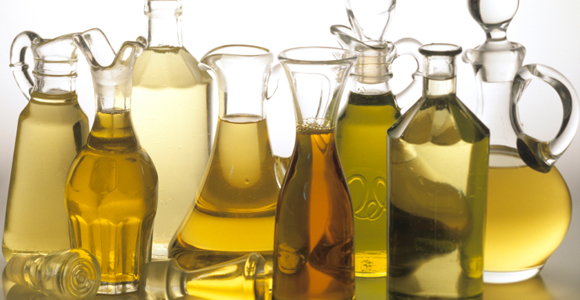A plethora of scientific research has proven that when it comes to health we need to make sure we consume enough healthy fats. However, more important than total fat is the type of fat in our diets. We all know that oils are much healthier than fats that come from animals (with the exception of coconut, palm kernel, and palm oils), particularly in relation to heart and brain health. Fats that come from animals have a much higher amount of saturated fat--the type of fat correlated with increased total cholesterol and LDL cholesterol, type 2 diabetes, and cardiovascular disease. But with so many different oils out there, how do you know which one is best for you?
All vegetable oils have a different nutrient content and specific uses in cooking. Although cooking oils are very similar in their calorie content, the nutrient content varies quite significantly from one oil to the next. All oils contain varying amounts of saturated fat, monounsaturated fat, and polyunsaturated fat. Additionally, oils have different uses in the kitchen.
Many of us are getting too many omega-6 fatty acids and not enough omega-3 fatty acids, throwing the ratio of the two off. It's recommended we increase our intake of monounsaturated fats in whole foods, such as olive oil and canola oil, while minimizing our intake of corn, soybean, and safflower oils, which are high in omega-6 fats.
Olive Oil
- Fat breakdown: 77% monounsaturated, 9% polyunsaturated, 14% saturated
- Nutrition benefits: Highest concentration of antioxidants among all of the oils, contains polyphenols that act as anti-inflammatory agents.
- Culinary uses: Versatile--can be used in marinades, salad dressings, sauces, dips, sautéed dishes, casseroles, stir-fries, meat dishes, and soups. Low smoke-point. Extra-virgin olive oil and virgin olive oil are recommended for fresh, cool dishes for which you want strong olive flavor, other varieties of olive oil can be used for cooking and baking.
Hazelnut Oil
Fat breakdown: 76% monounsaturated, 14% polyunsaturated, 10% saturated
Culinary uses: High smoke point. Used to provide flavor to meats, dressings, and baked desserts.
Avocado Oil
Fat breakdown: 70% monounsaturated, 10% polyunsaturated, 20% saturated
Culinary uses: Provides buttery, nutty, light avocado flavor to foods. Recommended for marinades and dressings, sautés, pasta dishes, casseroles, and meats. High smoke point--520° F.
Canola Oil
Fat breakdown: 62% monounsaturated, 32% polyunsaturated, 6% saturated
Nutritional benefits: Lowest amount of artery-clogging saturated fat of all oils, may decrease risk of cardiovascular disease.
Culinary uses: All-purpose oil best for dishes that require mild flavor. Often used for frying, general cooking and baking. Moderately high smoke point--400° F.
Peanut Oil
Fat breakdown: 49% monounsaturated, 33% polyunsaturated, 18% saturated
Nutrition benefits: Contains antioxidant resveratrol (thought to decrease risk of heart disease and cancer). May help reduce blood lipids.
Culinary uses: Imparts peanut flavor and aroma to dishes. Recommended for dishes suited for peanut flavoring, including Asian stir-fries, rice, noodles, and salads.
Sesame Oil
Fat breakdown: 40% monounsaturated, 46% polyunsaturated, 14% saturated
Nutrition benefits: Can lower cholesterol and protect the liver.
Culinary uses: Moderately high smoke point. Can be used as a condiment or cooking oil. Great in dipping sauces, salad dressings, and Asian dishes.
Palm Oil
Fat breakdown: 38% monounsaturated, 10% polyunsaturated, 52% saturated
Culinary uses: Enhances flavor of South American and Caribbean dishes. High smoke point.
Corn Oil
Fat breakdown: 25% monounsaturated, 62% polyunsaturated, 13% saturated fat
Culinary uses: Most often used for deep-frying or baking.
Soybean Oil
Fat breakdown: 24% monounsaturated, 61% polyunsaturated, 15% saturated
Culinary uses: Used in baking and deep-frying. High smoke point but heavy soybean flavor.
Sunflower Oil
Fat breakdown: 20% monounsaturated, 69% polyunsaturated, 11% saturated
Culinary uses: Light, imparts no flavor. High smoke point. Best for baking.
Walnut Oil
Fat breakdown: 19% monounsaturated, 67% polyunsaturated, 14% saturated
Culinary uses: Moderately high smoke point. Heavy walnut flavor. Must be refrigerated due to high rancidity. Useful in baked desserts, meats, and salad dressings.
Grape Seed Oil
Fat breakdown: 17% monounsaturated, 71% polyunsaturated, 12% saturated
Nutritional benefits: Antioxidants present may reduce risk of stroke and cardiovascular disease.
Culinary uses: Light, somewhat tart taste. Recommended for sautéing or frying.
Safflower Oil
Fat breakdown: 13% monounsaturated, 77% polyunsaturated, 10% saturated
Culinary uses: High smoke point with light flavor. Used to sear meats and deep-fry foods.
Coconut Oil
Fat breakdown: 6% monounsaturated, 2% polyunsaturated, 92% saturated fat
Culinary uses: Solid fat with low smoke point. Provides buttery texture to Southeast Asian dishes.
Kari Hartel, RD, LD is a Registered, Licensed Dietitian and freelance writer based out of St. Louis, MO. Kari is passionate about nutrition education and the prevention of chronic disease through a healthy diet and active lifestyle. Kari holds a Bachelor of Science in Dietetics from Southeast Missouri State University and is committed to helping people lead healthy lives. She completed a yearlong dietetic internship at OSF St. Francis Medical Center in Peoria, IL, where she worked with a multitude of clients and patients with complicated diagnoses. She planned, marketed, and implemented nutrition education programs and cooking demonstrations for the general public as well as for special populations, including patients with cancer, heart disease, diabetes, Alzheimer's disease, obesity, and school-aged children. Contact Kari at [email protected].



